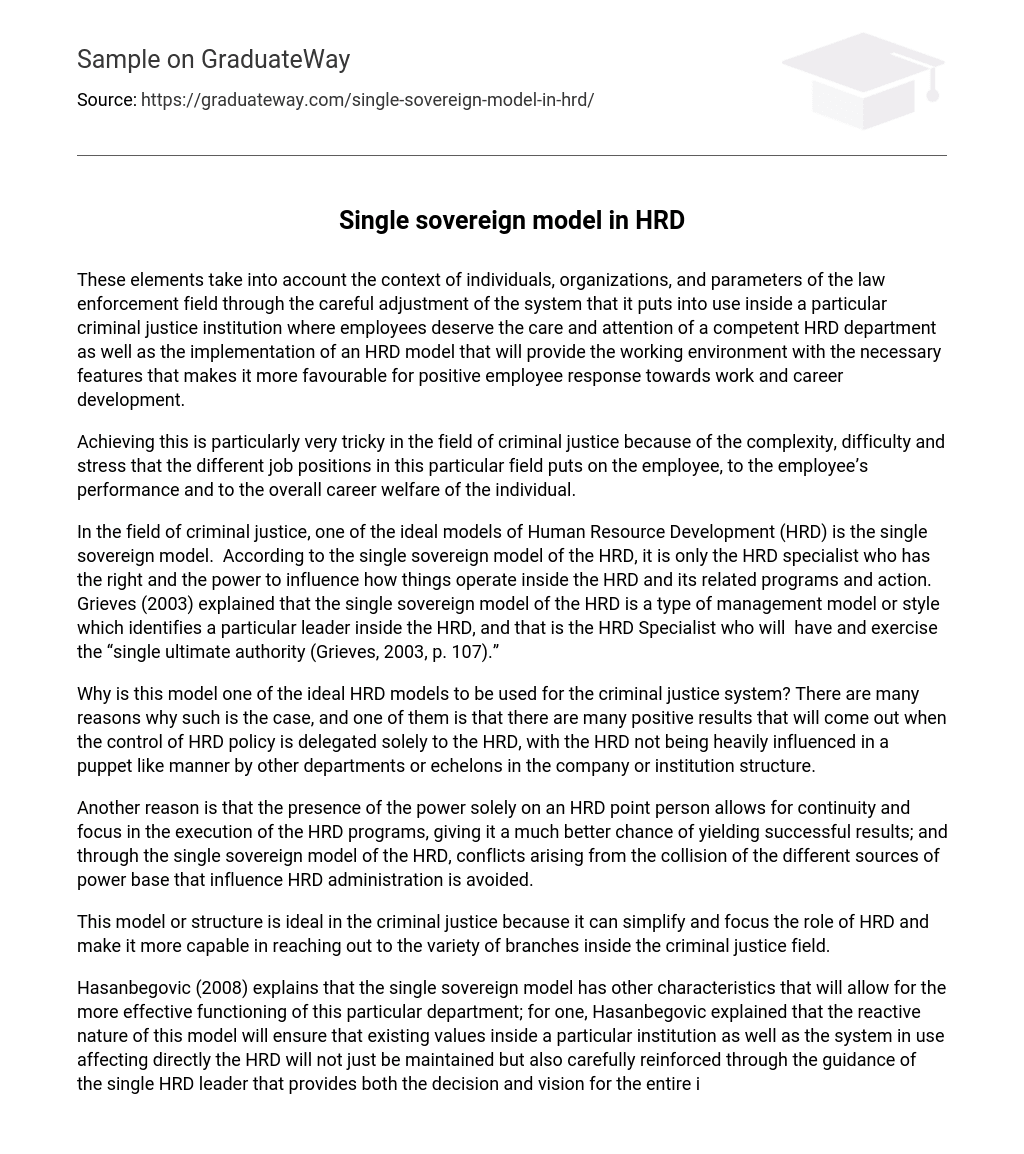These elements take into account the context of individuals, organizations, and parameters of the law enforcement field through the careful adjustment of the system that it puts into use inside a particular criminal justice institution where employees deserve the care and attention of a competent HRD department as well as the implementation of an HRD model that will provide the working environment with the necessary features that makes it more favourable for positive employee response towards work and career development.
Achieving this is particularly very tricky in the field of criminal justice because of the complexity, difficulty and stress that the different job positions in this particular field puts on the employee, to the employee’s performance and to the overall career welfare of the individual.
In the field of criminal justice, one of the ideal models of Human Resource Development (HRD) is the single sovereign model. According to the single sovereign model of the HRD, it is only the HRD specialist who has the right and the power to influence how things operate inside the HRD and its related programs and action. Grieves (2003) explained that the single sovereign model of the HRD is a type of management model or style which identifies a particular leader inside the HRD, and that is the HRD Specialist who will have and exercise the “single ultimate authority (Grieves, 2003, p. 107).”
Why is this model one of the ideal HRD models to be used for the criminal justice system? There are many reasons why such is the case, and one of them is that there are many positive results that will come out when the control of HRD policy is delegated solely to the HRD, with the HRD not being heavily influenced in a puppet like manner by other departments or echelons in the company or institution structure.
Another reason is that the presence of the power solely on an HRD point person allows for continuity and focus in the execution of the HRD programs, giving it a much better chance of yielding successful results; and through the single sovereign model of the HRD, conflicts arising from the collision of the different sources of power base that influence HRD administration is avoided.
This model or structure is ideal in the criminal justice because it can simplify and focus the role of HRD and make it more capable in reaching out to the variety of branches inside the criminal justice field.
Hasanbegovic (2008) explains that the single sovereign model has other characteristics that will allow for the more effective functioning of this particular department; for one, Hasanbegovic explained that the reactive nature of this model will ensure that existing values inside a particular institution as well as the system in use affecting directly the HRD will not just be maintained but also carefully reinforced through the guidance of the single HRD leader that provides both the decision and vision for the entire institution, like any institution operating inside the field of criminal justice that uses the function of the human resources development department (Hasanbegovic, 2008).
One of the possible elements of the single sovereign model of HRD when used in the criminal justice field may include the creation of HRD approach and design that allows for flexibility so that it can easily adapt to the needs of different professionals to which it caters to inside the field of the criminal justice (which focuses on the streamlining of the HRD approach to suit the needs of the professionals inside the field of criminal justice).
Also, there is the tracking, development and refinement of jobs and position that allows the field of criminal justice to present to its employees slots which they can use so that they can experience the opportunity for career development and the system of checking and cross checking the development of the careers of the professionals as well as assessment methods and tools that can allow the HRD to track not just career-based concerns but as well as other important concerns that affect the careers and the day-to-day performance of the members of its human resources.
References
Hasanbegovic, Jasmina (January 2008). Review of Stakeholders and strategic human
resource development by Garavan, Thomas N. (1995). Journal of European Industrial
Training, Vol. 19, No. 10, pp. 11–16. E-learning-reviews. Retrieved June 6, 2008,
From
http://www.elearning-reviews.org/topics/strategy/1995-gravan-stakeholders-strategic-human-resources/
Grieves, Jim and Grieves, James (February, 2003). Strategic Human Resource Development.
SAGE Publications.





